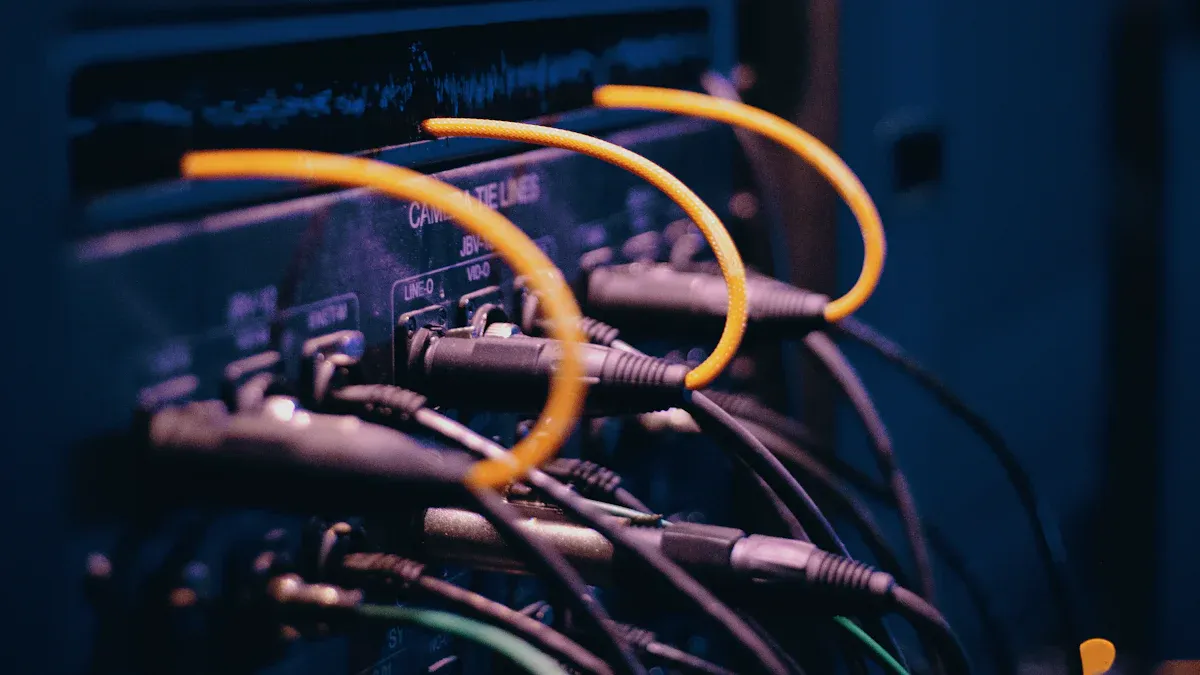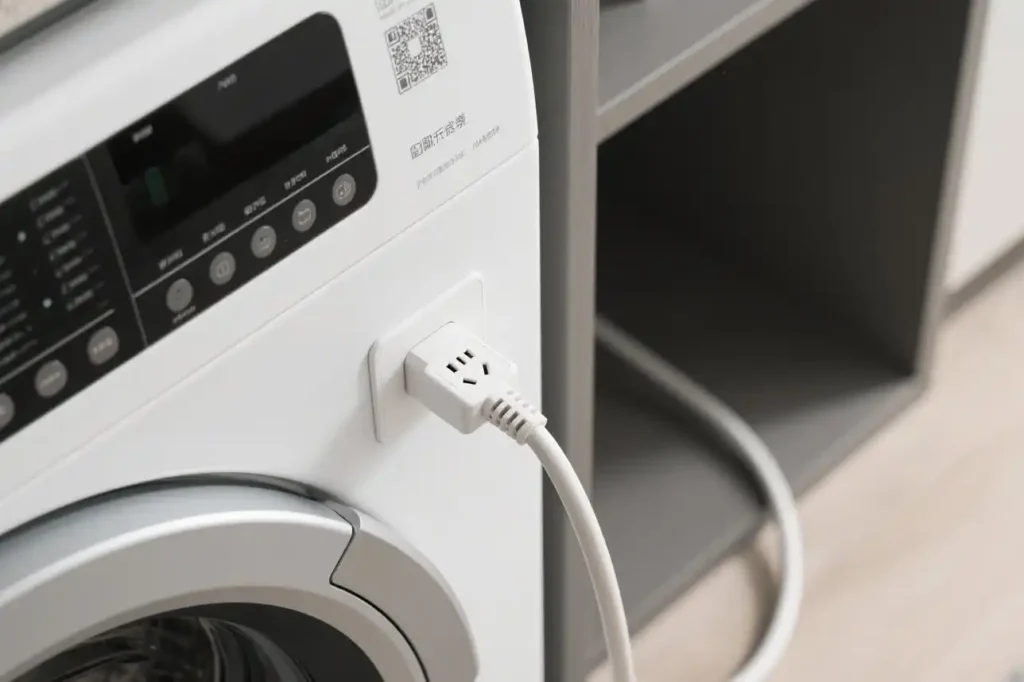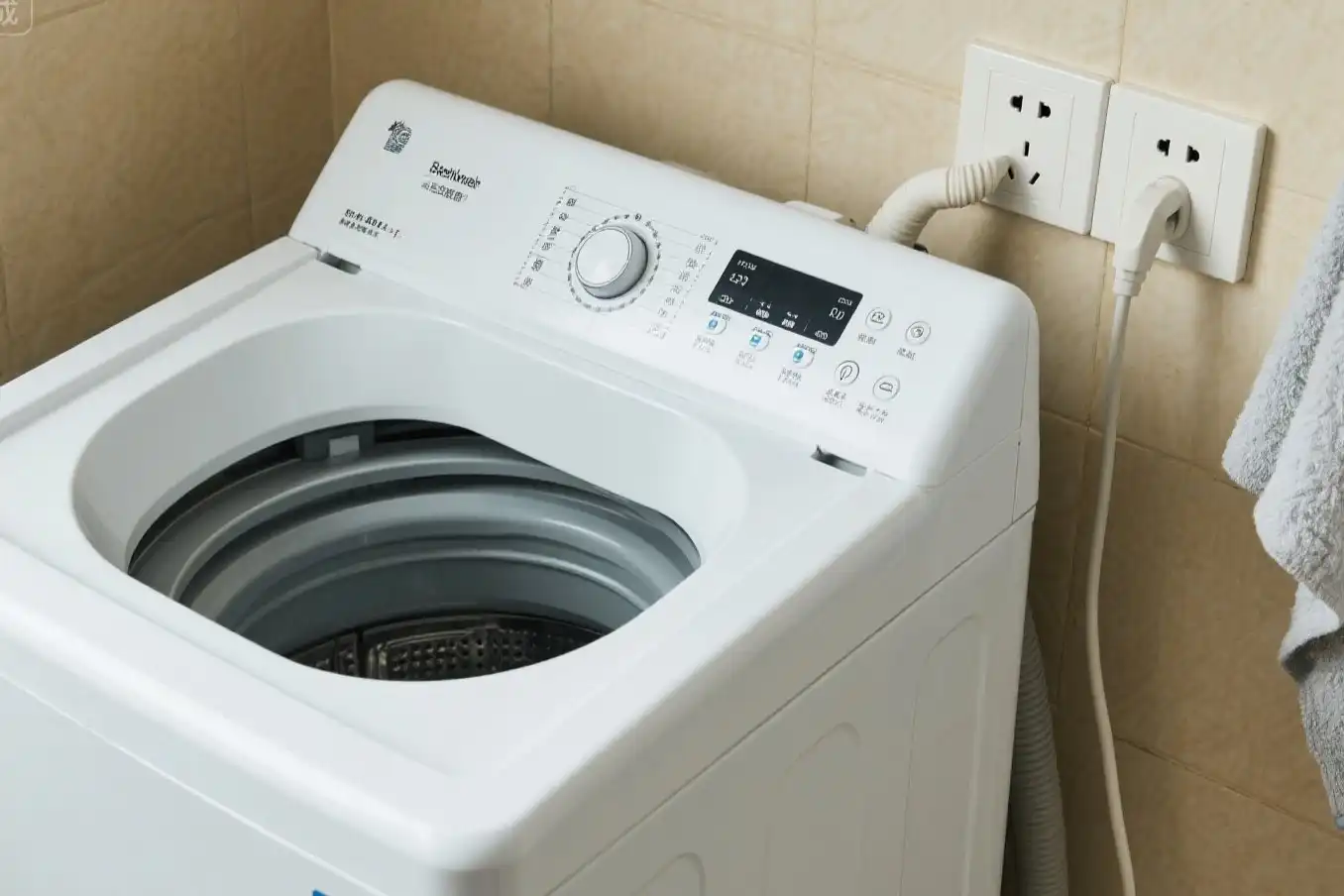You should not plug your washing machine into a regular washing machine socket. Most laundry rooms need their own circuit with grounding and GFCI protection to keep you safe. If you use a normal outlet or an extension cord instead of a proper washing machine socket, you could face problems like overheating, fire, or electric shock. Always make sure your washing machine socket follows safety regulations. By following these guidelines, you can keep your home and family safe.
Key Takeaways
- Always use a special 20-amp washing machine socket. Make sure it has GFCI protection and grounding. This helps keep your home safe.
- Do not plug your washing machine into a regular socket. Do not use extension cords. This can start fires or give electric shocks.
- Make sure your washing machine plug fits tightly. Check that it matches the socket’s voltage and amperage.
- Call a licensed electrician to put in or check your washing machine socket. This helps you follow safety rules and stay safe.
- Look for signs of socket problems like warm outlets, flickering lights, or burning smells. Stop using the socket if you notice these things.
Regular Sockets and Washing Machines
What Is a Regular Socket?
A regular socket is found in most rooms at home. People use these outlets for things like lamps or phone chargers. You can also plug in small appliances like microwaves. In the United States, these sockets give 120 volts. They are made for 15 or 20 amps. Bedrooms and living rooms usually have 15-amp outlets. Kitchens and bathrooms often use 20-amp outlets for more safety.
Here is a table showing the standard voltage and amperage for regular sockets in different countries:
| Country | Standard Voltage (Volts) | Standard Amperage (Amps) |
|---|---|---|
| USA | 120 | 15 or 20 |
| UK | 230 | 13 |
| Most of Europe | 230 | 16 |
| Australia | 230 | 10 |
Regular sockets are simple and made from plastic. They have small pins and are good for low-power devices. These outlets do not have extra safety parts for wet places or big appliances. If you plug a washing machine or tumble dryer into a regular socket, you might overload it. This could make the breaker trip or even cause a fire.
Tip: Always look at the label on your appliance and outlet before plugging in big appliances.
Washing Machine Socket Requirements
A washing machine socket is not the same as a regular socket. Washing machines need more power and special safety parts. The National Electrical Code (NEC) has rules for these sockets. You must use a 20-amp circuit just for the washing machine. This means no other device should use this socket. The socket also needs GFCI protection, especially near water. GFCI outlets turn off power fast if there is a problem. This helps stop electric shock.
Here are the main requirements for a washing machine socket:
- Use a 20-amp circuit just for the washing machine.
- Put in a GFCI outlet if water is close by.
- Make sure the socket is grounded and fits the washing machine plug.
- Place the socket where you can reach it easily.
- Follow local building codes for extra rules.
- Hire a licensed electrician to keep things safe.
Washing machine sockets are made with stronger materials. They have more safety features than regular sockets. These sockets can handle more power and keep out dust and water. They often look different from regular sockets. For example, a 20-amp socket in the US has a sideways T-shaped slot. This stops you from plugging in the wrong thing.
Some people think any plug works for washing machines, but that is not true. Using the wrong socket can cause power issues or break your appliance. It could even start a fire. Washing machines and other big appliances need sockets that fit their power needs. In other countries, you might need adapters or voltage converters to use your washing machine safely. Always use a grounded outlet and check that your socket meets local safety rules.
Note: Special washing machine sockets help stop electrical dangers and keep your appliance working well.
Washing Machine Plug and Power Needs
Typical Power Demands
It is important to know how much power your washing machine plug needs. Washing machines use different amounts of electricity in each wash cycle part. The main washing phase does not use much power. The spin cycle and water heating use a lot more. Here is a table that shows the average power used in each stage:
| Wash Cycle Stage | Power Consumption (Watts) |
|---|---|
| Main washing phase | Approximately 50 W |
| Spin cycle | Approximately 200 W |
| Water heating | Approximately 2,000 W |
| Average energy per run | 400 Wh to 1,400 Wh |
Most washing machines in the United States use 120 volts. When heating water, the machine can use up to 16.7 amps. Your washing machine plug must handle the highest power level. If you use an ENERGY STAR model or wash with cold water, you use less energy.
Front-loading washers use less electricity and water than top-loaders. You save money and energy with a front-loader. These washers spin faster, so clothes come out drier. This means your dryer does not work as hard, saving more power. Top-loaders use more water and energy, so they cost more to use.
Choosing the Right Plug for Your Washing Machine
You need to use the right plug for your washing machine plug. The correct plug keeps your home safe and your machine working well. When picking a plug for your washing machine, look at a few key things.
- Check the voltage and amperage on your washing machine plug.
- Make sure the plug fits tightly in the socket and does not move.
- Only use the plug that came with your machine or one the maker says is okay.
- Never use adapters or plugs that are not standard. These can cause overheating, electric shocks, or even fires. Fire safety experts say using double sockets or overloaded extension cords can cause accidents. In 2024, more than 1,100 electrical fires in England involved white goods like washing machines.
Tip: Always check your washing machine plug and socket for damage. Replace them if you see any problems.
The right plug type protects your machine and your home. If you are not sure, ask a licensed electrician. The main things to think about are the power rating, fit, and safety features. Using the correct washing machine plug helps stop electrical problems and keeps your laundry safe.
Safety and Code Requirements
GFCI and Grounding
It is important to know why GFCI protection and grounding are needed for washing machine sockets. GFCI means Ground Fault Circuit Interrupter. This device helps stop electric shock. If the GFCI finds a problem, it turns off the power very fast. The National Electrical Code (NEC) says all laundry room outlets must have GFCI protection. Since 2014, every laundry room in a house needs GFCI protection. In 2020, the NEC made this rule cover more outlets, even in business buildings. These rules help protect you from getting shocked.
- NEC says you need at least one 120V/20A circuit with GFCI protection in the laundry room.
- Since 2014, laundry circuits also need AFCI protection at the breaker.
- You can use a GFCI breaker or a GFCI outlet to follow the rules.
- If you use the LOAD side of a GFCI outlet to protect other outlets, you must put “GFCI Protected” stickers on them.
- You can use 15A outlets on a 20A laundry circuit, but only for laundry room outlets.
Grounding is just as important as GFCI protection. Grounding gives electricity a safe way to go into the earth if something goes wrong. This keeps the metal parts of your washing machine from being dangerous. If your machine is not grounded, you could get shocked by touching it and something else. Grounding uses a wire or a metal pipe. GFCIs make things even safer by turning off power if there is a problem.
- Grounding sends bad electricity safely into the earth.
- Without grounding, metal parts can shock you.
- Grounding connects the machine to a wire or pipe that goes to the earth.
- GFCIs and similar devices add more safety by turning off power fast.
- Bad grounding or old wires can cause fires, shocks, or hurt your appliances.
Tip: Always check that your washing machine socket has both GFCI protection and good grounding. This helps stop shocks, fires, and damage.
Dedicated Circuits
A dedicated circuit means only your washing machine uses that circuit. You should always plug your washing machine into its own circuit. This keeps the power steady and stops overloads. If you share a circuit with other things, you might trip breakers or hurt your machine. Local codes say you need a dedicated circuit for big appliances like washing machines.
| Aspect | Explanation |
|---|---|
| Power Demand | Washing machines need steady power. Dedicated circuits give them this. |
| Safety Risks | Sharing circuits can cause overloads, hot wires, and fires. |
| Appliance Performance | Dedicated circuits help your machine work well without stopping. |
| Code Compliance | Codes say you must use dedicated circuits for laundry appliances. |
| Consequences of Non-Compliance | Overloads, fire danger, appliance damage, and power loss can happen. |
| Additional Notes | Sharing outlets can lower voltage and make your machine not last as long. |
- Washing machines, especially big or new ones, work best with their own circuit.
- Sharing a circuit with other things can make wires too hot and cut power.
- Always ask a licensed electrician if you are not sure about your wiring.
You keep your home and washing machine safe by following these rules. You also follow the law and avoid problems with insurance or repairs. Using the right plug and socket is very important. This easy step keeps your laundry area safe and your machine working for a long time.
Risks of Improper Connections

Extension Cords and Socket Strips
Some people use an extension cord or socket strip for their washing machine. This may seem like an easy fix, but it is not safe. Washing machines need a lot of power to work right. Most extension cords and socket strips cannot handle this much power. If you use them, they can get too hot and might start a fire. Your washing machine could also get damaged.
Here are some dangers of using extension cords or socket strips:
- Cords can get too much power and overheat or catch fire.
- Plugging many strips together makes more heat and is unsafe.
- Using extension cords all the time breaks safety rules and is risky.
- Long cords make more heat because electricity has to travel farther.
- If the cord does not match your washing machine’s power, it can break.
- The washing machine can move and pull on cords, which can cause shocks.
Extension cords should only be used for a short time. If you use them all the time, you could start a fire. You might also lose your warranty. The best way is to put a special outlet close to your washing machine.
Overloading and Fire Hazards
If you plug your washing machine into a socket that is too weak, it can overload. Overloading happens when the washing machine needs more power than the socket can give. This can cause fires and hurt your home.
Look out for these signs that your socket is overloaded:
| Warning Sign | Explanation |
|---|---|
| Warm outlets or switch covers | Outlets feel hot because too much power is going through them. |
| Flickering or dimming lights | Lights get dim or flicker when the washing machine is on. |
| Frequent breaker trips | Breakers turn off a lot to stop damage. |
| Burning smells | A burning smell means something is too hot or damaged. |
| Scorched plugs or outlets | Burn marks show too much power went through the outlet. |
| Appliances lack power | The washing machine cannot start or run well. |
If you see any of these signs, stop using the socket right away. Call an electrician to check it. Overloaded sockets can cause fires, shocks, and break your washing machine. You can stop these problems by using the right socket and following safety rules.
Tip: Always use a dedicated, grounded outlet for your washing machine. This keeps your home safe and your appliance working well.
Safe Installation Tips
Checking Your Washing Machine Socket
You want your laundry area to be safe and reliable. Before you use your washing machine plug, check if the socket is suitable for the appliance. Follow these steps to make sure your washing machine socket meets safety standards:
- Confirm that the outlet matches your washing machine plug type. Check the voltage and amperage ratings to ensure they are correct.
- Make sure the outlet sits in a dry spot. Keep it away from water to lower the risk of electric shock.
- Use a dedicated circuit for your washing machine. This prevents overloads and keeps power steady.
- Ask a licensed electrician to inspect or install the socket. This helps you follow local codes and safety rules.
- Inspect the socket often. Look for loose connections, dirt, or signs of wear.
Tip: If you see burn marks, loose plugs, or hear buzzing, stop using the socket right away. These signs mean the socket is not safe.
When to Call a Professional
Some jobs need a licensed electrician. You should not try to fix or install a washing machine socket on your own in these cases. Here is a table to help you know when to call a professional:
| Situation Requiring Licensed Electrician | Reason / Explanation |
|---|---|
| Installing new dedicated circuits | New circuits must meet code and handle the washing machine’s power. |
| Ensuring proper grounding | Good grounding stops shocks and keeps your machine safe. |
| Installing GFCI outlets | GFCI outlets protect you from electric hazards near water. |
| Inspecting and updating wiring | Old or unsafe wiring needs a pro to check and fix it. |
| Local regulations require it | Some places only allow licensed electricians to do this work. |
Professional installation costs can vary. Installing a new outlet usually costs between $150 and $350. If you need a new circuit, expect to pay $250 to $900. Electricians charge $50 to $130 per hour. If you need to move washer or dryer hookups, the price can go up to $2,000. Upgrading the outlet behind your washer often means running a new 120-volt circuit, which costs about $250 in most homes.
Note: Paying for a professional now can save you from bigger problems later. You keep your home safe and make sure your washing machine plug works as it should.
Do not plug your washing machine into a regular socket. Laundry rooms need their own 20-amp circuit with GFCI and grounding. This helps stop overloads and keeps you from getting shocked.
- GFCIs turn off power fast if there is a problem. This keeps you safe when water is nearby.
- A dedicated circuit gives your washer steady power. It also lowers the chance of fire.
- Never use extension cords or put too many things in one outlet.
If you are not sure your setup is safe, call a licensed electrician. Keeping things safe helps protect your home and family every time you do laundry.
FAQ
What happens if you plug a washing machine into a regular socket?
The socket can get too much power. This might make the breaker turn off. Sometimes, it can even start a fire. Your washing machine might not work right. Always use a special outlet with grounding and GFCI protection.
What does a dedicated circuit mean for a washing machine?
A dedicated circuit is only for your washing machine. No other device uses this power. This keeps your washer safe. It also helps stop electrical problems.
What is GFCI protection, and why do you need it?
GFCI means Ground Fault Circuit Interrupter. This device turns off power if there is a problem. You need GFCI in laundry rooms to help stop electric shock. It is extra important where water is close by.
What should you do if your washing machine trips the breaker?
Stop using your washing machine right away. Look for signs of too much power or damage. If it keeps happening, call a licensed electrician. Do not try to fix electrical problems by yourself.
What is the safest way to install a washing machine socket?
You should get a licensed electrician to help. The electrician will put in a grounded, GFCI-protected outlet on its own circuit. This follows safety rules and helps protect your home and washing machine.
The following information may be of interest to you
What should I do if the circuit is overloaded?
What circuits need RCD protection
Can You Connect Multiple Surge Protectors Together Safely
What are the warning signs of surge protector failure
Connecting a Surge Protector to an Existing Breaker: What Happens




